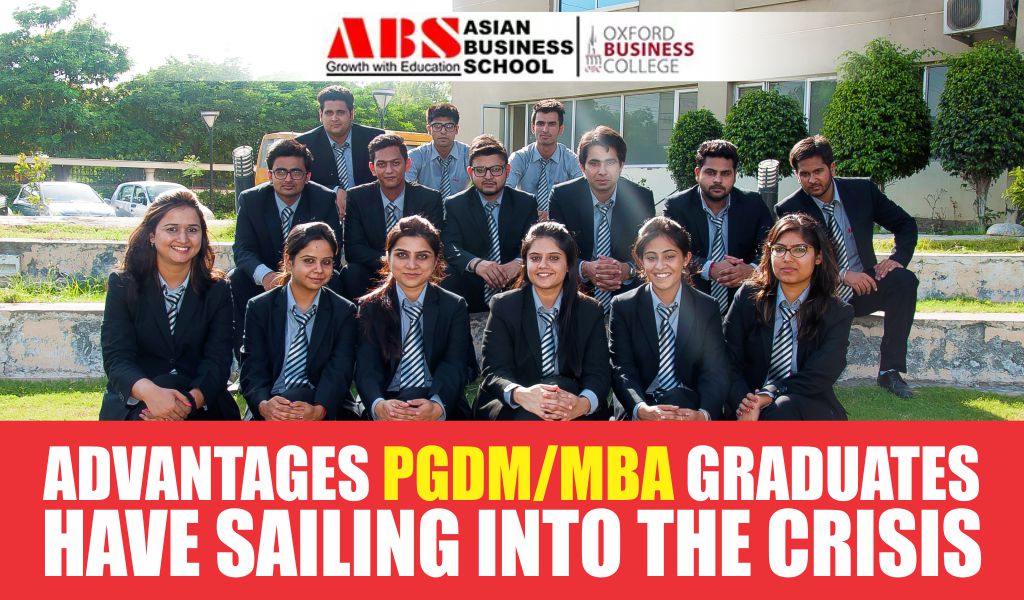Resilient MBA/PGDM: 5 Advantages PGDM/MBA Graduates Have Sailing Into The Crisis
April 15, 2020
Commonly, spring is the time of a year when, on the one hand, aspiring MBA/PGDM applicants decide on their choice business school for pursuing their studies while, on the other hand, graduating MBAs/PGDMs look at drawing the return on their investment and consider employment options. However, the only difference this year will be that they will be making these decisions in more uncertain times. The good news is that MBAs/PGDMs have five hidden advantages that make them more resilient and better able to succeed.
1) Yoga flexibility: This cohort has more dynamic thinking and can flex and bend and pivot business models. Dr. Anubhuti Dwivedi, Professor and Dean at Asian Business School (ABS), says business schools “can’t design a process that is rigid. Rather, we are designing processes that are changeable as the environment changes. MBAs/PGDMs learn flexibility with lean manufacturing systems, adaptability with technology, AI, dynamic pricing models, etc. One tool that I use in my class is a tornado diagram, whereby we identify the key risks, quantify their impact and develop mitigation strategies. This builds a business model that can recognize risks and can adapt accordingly.”
2) I-intelligence: With smartphones and mobile tech, most MBAs/PGDMs can work, shop, play and live anywhere. The shelter-in-place orders have cemented the virtual workplace. This new work style favours those who are tech-savvy and can thrive online. Many MBAs/PGDMs are quite practiced and comfortable in this mode. They have been taking their classes online, working in teams virtually and connecting with their friends on social media, and sharing information through the various online tools for years. As this crisis widens the digital divide, MBAs/PGDMs are generally found to be well-versed as technophiles. The careers that they aspire for are also virtually-resilient – like, technology startups, management consulting, investment banking, venture capital, strategic marketing, supply-chain optimization and many other white-collar management roles that adapt more easily to remote access.
3) Stamped passports: MBA/PGDM programs have been strengthening student’s global experience. Business schools have been trying hard to attract international students who bring unique perspective and networks. These international students of today can be the vital international supply chain or customer contact for tomorrow. MBA/PGDM programs also encourage study abroad semester programs and international study trips to study and travel overseas. The curriculum is also more international with case studies from non-Indian scenarios. After this crisis get over, a big priority will be to rebuild and diversify global supply chains and customer relationships. The crisis is eroding the global commerce and information fabric. It will need re-mending. Today’s MBAs/PGDMs are well prepared to jump in to repair and strengthen these tears.
4) Rubik’s thinking: In this crisis, we are facing multidimensional issues, such as balancing health risks with economic slowdown. Fortunately, this MBA/PGDM cohort is from a socially conscious generation. They are generally tuned to consider the impact on multiple constituents, such as shareholders and customers, but also the community, employees and the environment. In class at top B-schools, it has been noticed that MBA/PGDM students challenge the simple solution of optimizing around one variable such as Net Present Value. They would want a more complex calculus to factor in reputational effects, employee morale, product quality, community viability and environmental sustainability.
5) Battle scars: The average MBA/PGDM today is 27 and, in many cases, has a few years of work experience too. This is very different from a few decades ago where college graduates went directly to business school, with little if any work experience. Keep in mind that today’s average MBA/PGDM was only 15 during the 2008 financial crisis. To assure that MBAs/PGDMs do get the experience of working in real crisis, top B-Schools require a team consulting project to develop solutions for real problems posed by client companies. Many top business schools have similar MBA/PGDM consulting programs. What’s more, these companies often hire the MBAs/PGDMs at the end of the project.
Thus, MBAs/PGDMs today are a more resilient cohort. That, in many ways, turns out to be a good return on investment for the new graduates and the companies they join.











